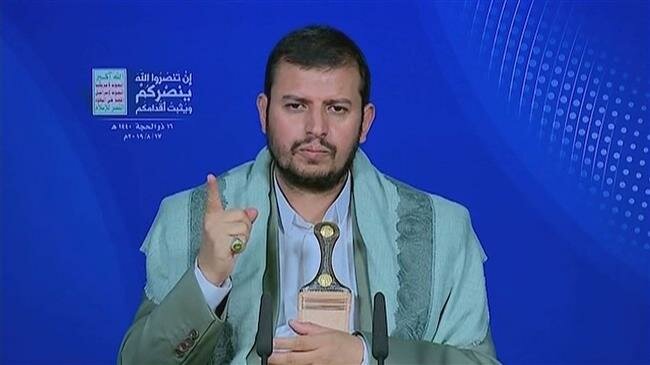Leader of Yemen’s Hezbollah Ansarullah movement warns Zionist Saudi Regime
The leader of Yemen’s Houthi Ansarullah movement has lauded a drone attack by Yemeni army forces and fighters from allied Popular Committees against the Shaybah oil field in eastern Saudi Arabia, saying the assault was the biggest of its kind in retaliation for the Riyadh regime's deadly military campaign against its southern neighbor.

Addressing his supporters via a televised speech broadcast live from the Yemeni capital, Sana’a, on Saturday afternoon, Abdul-Malik al-Houthi said no matter how appalling the crimes being perpetrated by the Saudi-led coalition against Yemen could be, such acts will fail to destroy the Yemeni nations’ morale.
“Today’s drone strike was the biggest of its kind ever since retaliatory attacks against the coalition of aggression have started. This major operation, dubbed Operation Deterrent Balance 1, proved that the aggressors have failed to bring the Yemeni nation to its knees. The aerial assault was launched using a squadron of ten combat drones and targeted Saudi Arabia’s biggest oil refinery near the border with the United Arab Emirates,” Houthi said.

10 Yemeni drones attack largest Saudi oil field near UAEAt least 10 Yemeni drones have attacked Saudi Arabia’s largest oil field at Shaybah near the UAE border, al-Masirah TV reports.
“The main goal of the [Saudi-led] coalition was to occupy Yemen and plunder its [natural] resources. Crimes, acts of aggression and violation of Yemen’s sovereignty will not satisfy the alliance’s demands. Aggressors and culprits liable for Yemen’s destruction have no legitimacy at all,” Ansarullah chief said.
Oil facilities at Shaybah, which has the largest strategic oil reserve in Saudi Arabia, were targeted by 10 Yemeni drones, the Yemeni broadcaster said Saturday.
The facilities attacked included a refinery and oil storage, al-Masirah TV said, citing Yemen’s armed forces spokesman Brigadier General Yahya Sare’e.
Houthi further noted that the United States and its regional allies are exploiting the Saudi-led military campaign against Yemen to their own advantage, emphasizing that the aggression has failed to shatter the Yemeni nation’s unity.

Aden infighting: ‘UK legacy of divide and conquer’A Yemeni activist says the recent infighting between Emirati- and Saudi-backed militants in the southern port city of Aden is the embodiment of the UK’s “legacy of divide and conquer.”
The Ansarullah leader also censured the involvement of militiamen loyal to Yemen’s former president Abd Rabbuh Mansur Hadi in the massacre of Yemeni people, saying that long-standing feuds and attempts to settle old scores with other factions have led them to play in the hands of the aggressors and provide a cover for them.
“Hadi has no legitimacy and no popular support in Yemen. Saudi Arabia and the UAE are caught in the Yemen quagmire with no end in sight. Hadi loyalists have become pawns in their sponsors’ hands, and are providing enemies with pretexts to occupy Yemen,” Houthi pointed out.

Infighting kills 40, wounds 260 in Yemen’s Aden: UNThe UN says recent infighting between Saudi-backed militia and UAE-backed separatists in Yemen’s Aden has killed 40 people and wounded 260 others.
“Hadi can enter [the southern Yemeni port city of] Aden only after having obtained permission from the UAE. What is described as the legitimate Yemeni government is simply a sham administration, whose head only makes short trips to the country. Socotra Island together with the province of al-Mahrah and Hadhramaut were under Hadi control. Aggressors, nevertheless, crossed into the regions and wrested control over them. The invaders well know that the situation in Yemen is volatile, and they cannot control the entire Yemen from there,” the Ansarullah head stressed.
Houthi then advised Hadi loyalists to end deception and return to the Yemeni nation’s side.
He said the Ansarullah movement wishes to forge strong relations with Iran, emphasizing that his group is seeking to cooperate with all Muslim states.

Leader warns of Saudi-UAE plot to split YemenAyatollah Khamenei calls for strong resistance in the face of a Saudi-UAE plot to partition Yemen.
“Iran has never imposed any diktats upon us. It is threading the path of opposition to US hegemony and support for the Palestinian cause. The Islamic Republic of Iran’s stance concerning condemnation of the Saudi-led aggression on Yemen has been fairly clear,” Houthi said.

Israel working on ‘transparent normalization’ with ArabsIsraeli Foreign Minister Israel Katz says he is working toward “transparent normalization” of diplomatic ties with Persian Gulf littoral states.
The Ansarullah chief described Israel as a dire threat to the Muslim world, condemning attempts by certain Arab states to normalize diplomatic relations with the zionist regime.







